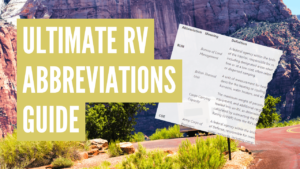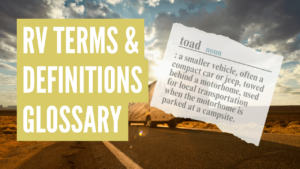GAWR, which stands for Gross Axle Weight Rating, is an important metric that has legal implications if not adhered to.
Let’s look at the meaning of GAWR, how to determine your vehicle or trailer’s rating, how it compares to GVWR, and more!
What is Gross Axle Weight Rating?
Gross Axle Weight Rating (GAWR) is the maximum weight that can be safely supported by a single axle on an RV or tow vehicle, including the weight of the vehicle itself, cargo, fluids, and passengers.
You can determine if your vehicle is within the acceptable GAWR limit by separately weighing the front and rear ends after it’s fully loaded with fluids, cargo, and passengers.
Types of GAWR
On dual-axle vehicles, you will find two types of GAWR: front and rear. The front GAWR refers to the maximum weight that the front axle of a vehicle can support. The rear GAWR refers to the maximum weight the rear axle can support.
Here’s an example Safety Compliance Certification Label that can be found inside the driver’s side door jamb of a Ford F-Series truck showing the front and rear GAWR.

You can often find a GAWR for single-axle trailers, as well. Here’s an example of a Crossroads Zinger travel trailer displaying its GAWR on its website.

Importance of Following GAWR Limits
It’s important to follow the GAWR limits set by the vehicle manufacturer to avoid certain risks, including the following:
- Premature wear and tear of the vehicle’s components, such as the axles, frame, tires, and brakes.
- Potential to cause an accident, especially if a component of your vehicle breaks due to the added strain.
- It’s illegal and can result in fines, penalties, or even impounding the vehicle.
How to Determine Your Vehicle’s GAWR
To determine your vehicle’s GAWR, you can check the Safety Compliance Certification Label that can be found inside the driver’s side door jamb. On a dual-axle vehicle, there should be both a front and rear GAWR on the label.
If you can’t find the label, contact your local dealer for the GAWR information for your specific make and model.
What Is the Difference Between GVWR and GAWR?
Gross Vehicle Weight Rating (GVWR) and Gross Axle Weight Rating (GAWR) are two important terms to understand when it comes to vehicle weight limits. Here’s the difference between the two:
- GVWR is the maximum weight a vehicle can carry, including the weight of the vehicle itself, passengers, cargo, and fuel. It is determined by the vehicle manufacturer and takes into account the strength and capacity of the axles, tires, brakes, and other components.
- GAWR, on the other hand, is the maximum weight that can be safely supported by a single axle on an RV or tow vehicle, including the weight of the vehicle itself, cargo, fluids, and passengers.
In other words, GVWR is the total weight the vehicle can carry, while GAWR is the weight that each axle can carry.
It’s important to follow both GVWR and GAWR limits to ensure that the vehicle is not overloaded and to avoid potential safety hazards. Exceeding either limit can result in damage to the vehicle, unsafe driving conditions, and possible legal implications.
Why Is GAWR Lower Than GVWR?
GAWR is lower than GVWR because the rating number is per axle, as the front and rear typically have different ratings. That said, when you add the two axles together, it’s typically higher than GVWR, which can also be confusing.
Let’s say a vehicle has a GVWR of 10,000 pounds, with a front GAWR of 4,500 pounds and a rear GAWR of 6,000 pounds. This means that the front axle can support a maximum weight of 4,500 pounds, while the rear axle(s) can support a maximum weight of 6,000 pounds. The total weight that the vehicle can carry is 10,000 pounds, but it must be distributed in a way that does not exceed the GAWR limits for each axle.
How to Not Exceed the GAWR Limits
Staying within the GAWR limits is crucial for vehicle safety. Here are some tips to ensure you don’t exceed the GAWR limit for both axles:
- Familiarize yourself with the GAWR of your vehicle and trailer. Remember, the GAWR should be displayed right on your door frame when you open your driver’s side door.
- Proper loading techniques can help distribute the weight how you need across the axles.
- Weigh both the front and rear ends of your vehicle after it’s fully loaded with fluids, cargo, and passengers to ensure both axles are within the GAWR limit.
Other Important Towing Terms

- GCWR: GCWR, or Gross Combined Weight Rating, is the maximum allowable combined weight of a towing vehicle (including passengers and cargo) and the towed vehicle (or trailer), including its cargo.
- GTWR: GTWR, or Gross Trailer Weight Rating, is the maximum allowable weight of a fully loaded trailer, including its cargo.
- GVWR: GVWR, or Gross Vehicle Weight Rating, is the maximum weight an RV or tow vehicle can safely carry, including the vehicle itself, passengers, cargo, and fluids, as determined by the manufacturer.
- Pin Weight: King Pin Weight, also known as Pin Weight or Fifth Wheel Pin Weight, is the amount of a trailer’s weight that rests on the hitch of a towing vehicle when using a fifth-wheel or gooseneck hitch.
- Tongue Weight: Tongue Weight is the downward force exerted by the trailer’s coupler onto the hitch ball of the towing vehicle.
Check out our RV Terms & Definitions and RV Abbreviations guide
Download Our RV Terms & Definitions Guide (With Abbreviations & Slang)

This comprehensive, 17-page printable guide contains the most common terms, abbreviations, and slang used in the RV community! Over 150 essential terms and their meanings, organized alphabetically, that you can access anywhere! Don’t travel without it!







Write a comment